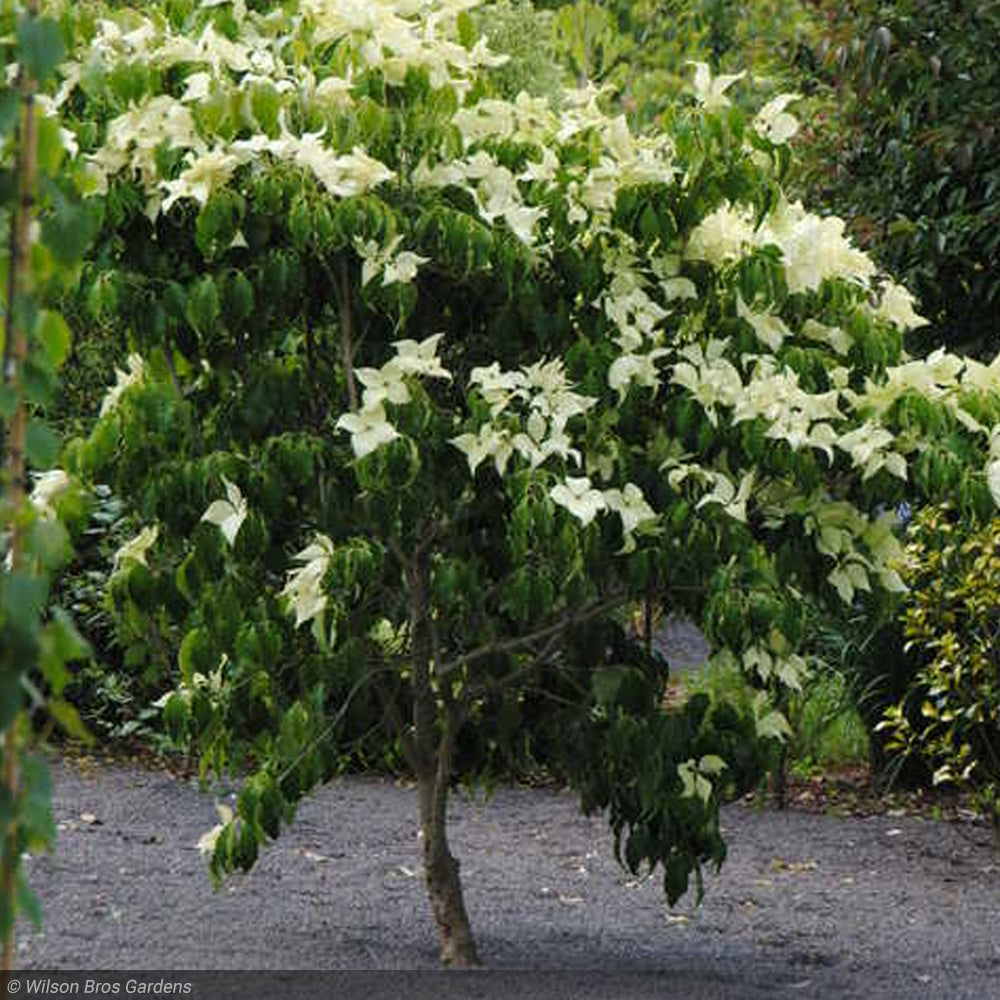Greensleeves Kousa Dogwood
The history of Cornus kousa (Greensleeves Kousa Dogwood) goes deep into the temperate areas of East Asia. Cornus stands as a culturally significant species throughout China, Korea, and Japan due to its beauty and medicinal properties while having existed in these landscapes for hundreds of years. Ancient Chinese records document the use of this plant in imperial gardens where it represented renewal and strength through its cultivation. The Japanese tradition of planting this species near temples and shrines reflects their cultural connections to peace and enlightenment.
During the late 19th century Western plant explorers discovered Cornus in Asia and transported its specimens to Europe and North America. By the start of the 20th century this species became a featured plant in botanical gardens due to its appealing look and ability to adapt. The tree became a valued feature in arboretums and private gardens across the globe as years passed.
Traditional Medicinal Uses
For its medicinal properties Cornus has served people for a long time beyond its ornamental value. Traditional Asian medicine utilizes different sections of the tree due to their healing properties. Herbal preparations have employed the bark to treat fevers and inflammation, and people have appreciated the fruit for its nutritional value and digestive support. The small round fruit contains antioxidants and vitamins and has served historically as a tonic to improve health and increase energy levels.
Research into extracts from leaves and bark shows possible antibacterial and antifungal effects which help treat minor infections. Traditional medicine techniques involved applying a paste created from crushed leaves to wounds and bruises to accelerate healing. The scientific examination of Cornus's medicinal properties continues to develop while herbalists and botanists maintain their interest in this plant.
Introduction to the Western World
The late 1800s saw Greensleeves Kousa Dogwood enter Western horticulture after plant-collecting missions in East Asia brought it over. After first growing in botanical gardens Cornus started appearing in private gardens because of its unique look and adaptability to multiple climates. The debut of Cornus in Western horticulture occurred during a period of rising interest in Asian plants which earned it admiration from gardeners and botanists across Europe and America.
Landscape architects preferred this species because it could grow in various soil conditions and showed resilience against multiple plant diseases. The propagation efforts of nurseries made it widely available which led to its increasing popularity until it established itself as a common feature in parks, estates, and city green spaces.
Greensleeves Kousa Dogwood Ornamental Appeal in Landscapes
Cornus stands out as an exceptional specimen in landscape design because of its remarkable seasonal transformations. The Cornus plant displays star-shaped bracts which start as creamy white in spring before gradually turning to soft pink. The bracts that look like petals surround a small central flower cluster and stand out against the plant's deep green leaves.

During summer months the tree produces a large amount of distinctive berry-like fruit that matures into a deep red color. Visually appealing textured fruit adds dynamic garden interest through its ability to attract wildlife. The leaves transform into stunning colors of crimson, orange and deep burgundy when autumn arrives making this tree one of the finest examples of fall foliage color.
Cornus continues to enhance landscape beauty throughout winter months. The tree displays year-round appeal as its bark peels off in random sections to expose a pattern of tan, gray and brown. The tree's feature proves especially valuable for winter gardens because it offers texture and structure throughout the dormant season.
Unique Wildlife Attraction
Cornus stands out because it provides habitat and resources for a broad range of wildlife species. Birds such as thrushes, waxwings, and woodpeckers heavily depend on the fruit of this tree as their food supply during the late season. Nectar-rich flowers on the plant draw bees and butterflies to gardens which helps to expand biodiversity.
The tree hosts specific moth species that are rare in nature since their larvae use its leaves for sustenance while maintaining the ecosystem's balance. Small mammals like chipmunks and squirrels frequently collect dropped fruit which adds value to wildlife-friendly landscapes. Cornus planting allows gardeners to promote ecological variety alongside appreciating its inherent aesthetic appeal.
Exceptional Hardiness and Growth Characteristics Of Greensleeves Kousa Dogwood
Greensleeves Kousa Dogwood demonstrates exceptional strength and versatility in different environments. This ornamental tree stands out from its counterparts because it shows remarkable resistance to common diseases that often affect similar species such as anthracnose. The tree adapts to diverse soil types ranging from loamy to slightly acidic conditions which makes it suitable for many different growing environments.
This species flourishes in harsh winter areas because of its exceptional ability to withstand cold temperatures. This tree shows resilience to extreme cold and manages to survive the intense heat and moisture of southern regions. With appropriate maintenance this plant reaches its full potential across USDA hardiness zones 5 through 8 which makes it suitable for diverse landscape environments.
Cornus grows at a moderate pace to achieve a mature height between 15 and 30 feet. The elegant and layered branch structure of Cornus makes it ideal for skillful pruning which enables homeowners and landscape designers to shape the tree to fit their desired look. This species stands out as a dramatic central feature whether grown as a single plant or combined with other plants in mixed borders.
Greensleeves Kousa Dogwood A Tree of Timeless Beauty
Greensleeves Kousa Dogwood represents a combination of historical significance, enduring strength and decorative appeal. The tree stands out as a remarkable garden choice because it has ancient roots and provides both medicinal and ecological benefits. The year-round attractiveness of this tree through its spectacular flower displays and bright fall colors as well as its winter bark texture keeps it highly popular among both gardening experts and nature lovers. This species demonstrates how nature and cultivated landscapes can exist in harmony through its aesthetic appeal and support for wildlife.